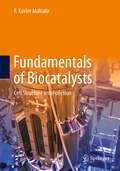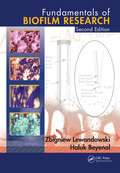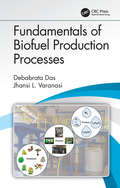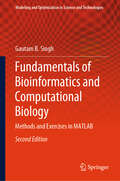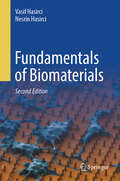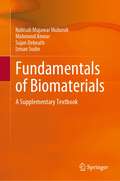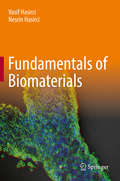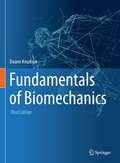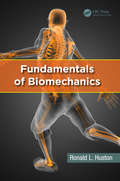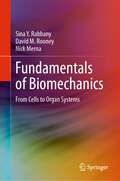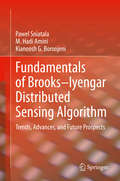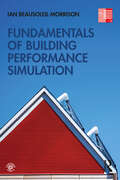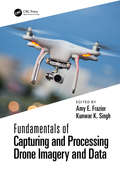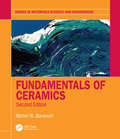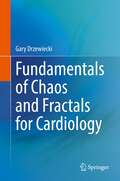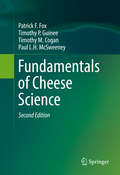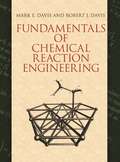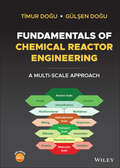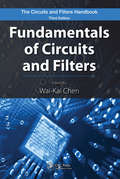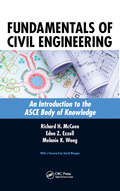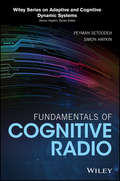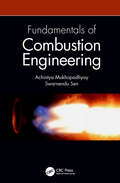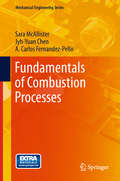- Table View
- List View
Fundamentals of Biocatalysts: Cell Structure and Function
by F. Xavier MalcataThis textbook covers the essentials of cells as biocatalysts, including cell morphology, cell genetics, cell metabolism, cell operation, cell stoichiometry, cell engineering, and cell interaction. A pragmatic and systematic approach is provided to all such topics, from the point of view of a biological engineer – illustrated by criteriously selected and carefully solved problems, proposed at the end of each section. In the first part of this textbook, readers will find a brief historical review of biotechnology; and in the second part, the author explores the performance of biocatalysts, in terms of native features and upon rational manipulation thereof. Whenever appropriate, mathematical derivations are put forward that are easy to follow step-by-step – even by students holding only elementary mathematical and biochemical backgrounds; and are developed at a pace suitable for self-learning. Furthermore, the functional forms and meanings of the expressionsproduced are explored, and the final germane formulae are duly highlighted and graphically interpreted in dimensionless form – to facilitate the perception of major trends and asymptotic patterns. Therefore, this book offers a valuable resource for both instructors and undergraduate/graduate students – as an aid to grasp and relate basic concepts dealing with living cells as catalysts designed for bioreactors, rather than engaging in cumbersome descriptions of their physiological behaviour.This textbook, together with the companion volumes Operation Fundamentals in Bioreactor Engineering and Modelling Fundamentals in Bioreactor Engineering, fill the gap between qualitative approaches, focused on biochemistry; and technological approaches, which often resort to empirical correlations – unlikely to support a fundamental understanding of the essential concepts.
Fundamentals of Biofilm Research
by Haluk Beyenal Zbigniew LewandowskiThe six years that have passed since the publication of the first edition have brought significant advances in both biofilm research and biofilm engineering, which have matured to the extent that biofilm-based technologies are now being designed and implemented. As a result, many chapters have been updated and expanded with the addition of sections
Fundamentals of Biofuel Production Processes
by Debabrata Das Jhansi L. VaranasiFocusing on fundamentals of biofuel production from renewable energy sources and biohydrogen production, this book offers a complete understanding of the bioconversion processes. Each chapter begins with a fundamental explanation for general readers and ends with in-depth scientific details suitable for expert readers. It discusses different types of production technologies covering basic concepts, production strategies, commercial usage, and advances.
Fundamentals of Bioinformatics and Computational Biology: Methods and Exercises in MATLAB (Modeling and Optimization in Science and Technologies #19)
by Gautam B. SinghThis book comprehensively covers all the core bioinformatics topics and includes practical examples completed using the MATLAB bioinformatics and machine learning toolboxes™. It is primarily intended as a textbook for engineering and computer science students attending advanced undergraduate and graduate courses in bioinformatics and computational biology. The book develops bioinformatics concepts from the ground up, starting with an introductory chapter on molecular biology and genetics to enable physical science students to appreciate the challenges in biological data management, sequence analysis, and systems biology. The book is divided into five parts. The first one includes a survey of existing biological databases and tools that have become essential in today’s biotechnology research. The second part covers methodologies for retrieving biological information, including fundamental algorithms for sequence comparison, scoring, and determining evolutionary distance. The third part of the book focuses on modeling biological sequences and patterns as Markov chains, covering core principles for analyzing and searching for sequences of significant motifs and biomarkers and developing stochastic ergodic hidden Markov models for biological sequence families. The fourth one is dedicated to systems biology and covers phylogenetic analysis and evolutionary tree computations, as well as gene expression analysis with microarrays. In turn, the last part of the book includes an introduction to machine-learning algorithms for bioinformatics and outlines strategies for developing intelligent diagnostic machine-learning applications, RNA sequence data, and deep learning systems for mass spectrometry data. All in all, this book offers a unique hands-on reference guide to bioinformatics and computational biology. This second edition has been updated to cover additional and most recent databases, and machine learning and deep learning applications in RNA sequence and mass-spectrometry data analysis. Moreover, it presents significant enhancements to the chapter dedicated to microarray analysis, and more practical examples, with additional end-of-chapter problems.
Fundamentals of Biomaterials
by Vasif Hasirci Nesrin HasirciThis comprehensive and engaging text, now in an expanded second edition, is meant for advanced undergraduate and graduate students and covers the fundamental relationships between the structure and properties of materials and biological tissues. The successful integration of material and biological properties, shape, and architecture to engineer a wide range of optimized designs for specific functions is the ultimate aim of a biomaterials scientist. Relevant examples illustrate the intrinsic and tailored properties of metallic, ceramic, polymeric, carbon-derived, naturally-derived, and composite biomaterials. Information about translation of biomaterials to clinical medical devices is included. Fundamentals of Biomaterials, 2nd Ed. is written in a single voice, ensuring clarity and continuity of the text and content. As a result, the reader will be gradually familiarized with the field, starting with materials and their basic properties and eventually leading to critical interactions with the host environment. The authors also present new topics such as tissue engineering, guided tissue regeneration, and nano- and micro- architecture of biomaterial surfaces. Full of important medical and biological definitions, essential applications, detailed examples, and interesting chapter-ending summaries, this book serves as an incredibly useful teaching text and as a modern introduction to biomaterials research. This second edition includes new chapters on the historical development of biomaterials, transplants and implants, characterization techniques, and biomedical device production, as well as an expanded chapter on human biology that now also includes biological systems (cardiovascular, respiratory, digestive, nervous, etc.), plus much more.
Fundamentals of Biomaterials: A Supplementary Textbook
by Nabisab Mujawar Mubarak Mahmood Anwar Sujan Debnath Izman SudinThis book encompasses Materials Engineering with Medical Science which introduces the depth of knowledge from beginning with relevant fundamentals. This book fills the void which comprises a broad range of Materials Engineering with Medical science, from atomic physics to histology. This book greatly benefits towards those engineering students who are least familiar with biological science as well as medical science.
Fundamentals of Biomaterials: An Introduction
by Vasif Hasirci Nesrin HasirciThis text for advanced undergraduate and graduate students covers the fundamental relationships between the structure and properties of materials and biological tissues. The successful integration of material and biological properties, shape, and architecture to engineer a wide range of optimized designs for specific functions is the ultimate aim of a biomaterials scientist. Relevant examples illustrate the intrinsic and tailored properties of metal, ceramic, polymeric, carbon-derived, composite, and naturally derived biomaterials.Fundamentals of Biomaterials is written in a single voice, ensuring clarity and continuity of the text and content. As a result, the reader will be gradually familiarized with the field, starting with materials and their properties and eventually leading to critical interactions with the host environment. Classical and novel examples illuminate topics from basic material properties to tissue engineering, nanobiomaterials, and guided tissue regeneration.This comprehensive and engaging text:integrates materials and biological properties to understand biomaterials function and designprovides the basics of biological tissue components and hierarchyincludes recent topics from tissue engineering and guided tissue regeneration to nanoarchitecture of biomaterials and their surfacescontains perspectives/case studies from widely-recognized experts in the fieldfeatures chapter-ending summaries to help readers to identify the key, take-home messages.
Fundamentals of Biomechanics
by Duane KnudsonBlending up-to-date biomechanical knowledge with professional application knowledge, this second edition presents a clear, conceptual approach to understanding biomechanics within the context of the qualitative analysis of human movement. It develops nine principles of biomechanics, which provide an applied structure for biomechanical concepts, and the application of each principle is fully explored in several chapters. The book also offers real-world examples of the application of biomechanics, which emphasize how biomechanics is integrated with the other subdisciplines of kinesiology to contribute to qualitative analysis of human movement.
Fundamentals of Biomechanics
by Ronald L. HustonIn the last three or four decades, studies of biomechanics have expanded from simple topical applications of elementary mechanics to entire areas of study. Studies and research in biomechanics now exceed those in basic mechanics itself, underlining the continuing and increasing importance of this area of study. With an emphasis on biodynamic modeli
Fundamentals of Biomechanics: From Cells to Organ Systems
by Sina Y. Rabbany David M. Rooney Nick MernaFundamentals of Biomechanics: From Cells to Organ Systems combines biology with engineering to provide a comprehensive overview of biomechanics. It covers cell, tissue, and fluid mechanics in a way that is easy to understand, requiring only a basic background in biology and mechanics. The book includes a wide range of topics, from single-cell mechanics to forces in the musculoskeletal system. Each chapter provides an introduction to biological systems, along with examples and practice problems throughout the text. The book also offers step-by-step derivation of equations from principles. This textbook has been classroom-tested and is designed for advanced undergraduate engineering courses in bioengineering, biomechanics, and physiology. It is also a valuable reference for graduate students, practicing engineers, and medical professionals. Integrates biology with engineering; Includes examples and practice problems throughout the text; Requires a limited background in biology and mechanics.
Fundamentals of Brooks–Iyengar Distributed Sensing Algorithm: Trends, Advances, and Future Prospects
by Kianoosh G. Boroojeni M. Hadi Amini Pawel SniatalaThis book provides a comprehensive analysis of Brooks-Iyengar Distributed Sensing Algorithm, which brings together the power of Byzantine Agreement and sensor fusion in building a fault-tolerant distributed sensor network. The authors analyze its long-term impacts, advances, and future prospects. The book starts by discussing the Brooks-Iyengar algorithm, which has made significant impact since its initial publication in 1996. The authors show how the technique has been applied in many domains such as software reliability, distributed systems and OS development, etc. The book exemplifies how the algorithm has enhanced new real-time features by adding fault-tolerant capabilities for many applications. The authors posit that the Brooks-Iyengar Algorithm will to continue to be used where fault-tolerant solutions are needed in redundancy system scenarios.This book celebrates S.S. Iyengar's accomplishments that led to his 2019 Institute of Electrical and Electronics Engineers' (IEEE) Cybermatics Congress "Test of Time Award" for his work on creating Brooks-Iyengar Algorithm and its impact in advancing modern computing.
Fundamentals of Building Performance Simulation
by Ian Beausoleil-MorrisonFundamentals of Building Performance Simulation pares the theory and practice of a multi-disciplinary field to the essentials for classroom learning and real-world applications. Authored by a veteran educator and researcher, this textbook equips graduate students and emerging and established professionals in engineering and architecture to predict and optimize buildings’ energy use. It employs an innovative pedagogical approach, introducing new concepts and skills through previously mastered ones and deepening understanding of familiar themes by means of new material. Covering topics from indoor airflow to the effects of the weather, the book’s 19 chapters empower learners to: Understand the models and assumptions underlying popular BPS tools Compare models, simulations, and modelling tools and make appropriate selections Recognize the effects of modelling choices and input data on simulation predictions And more. Each subject is introduced without reference to particular modelling tools, while practice problems at the end of each chapter provide hands-on experience with the tools of the reader’s choice. Curated reading lists orient beginners in a vast, cross-disciplinary literature, and the critical thinking skills stressed throughout prepare them to make contributions of their own. Fundamentals of Building Performance Simulation provides a much-needed resource for new and aspiring members of the building science community.
Fundamentals of Building Performance Simulation
by Ian Beausoleil-MorrisonFundamentals of Building Performance Simulation, Second Edition pares the theory and practice of a multi-disciplinary field to the essentials for classroom learning and real-world applications. Authored by a veteran educator and researcher, this textbook equips students and emerging and established professionals in engineering and architecture to predict and optimize building energy use. It employs an innovative pedagogical approach, introducing new concepts and skills through previously mastered ones and deepening understanding of familiar themes by means of new material.Covering topics from indoor airflow to the effects of the weather to HVAC systems, the book’s 25 chapters empower learners to: Understand the models and assumptions underlying BPS tools Compare models, simulations, and modelling tools and make appropriate selections Recognize the effects of modelling choices and input data on simulation predictions Each subject is introduced without reference to particular simulation tools, while practice problems at the end of each chapter provide hands-on experience with the tools of the reader’s choice. Curated reading lists orient beginners in a vast, cross-disciplinary literature, and the critical thinking skills stressed throughout prepare them to make contributions of their own. Fundamentals of Building Performance Simulation, Second Edition provides a much-needed resource for new and aspiring members of the building science community.The textbook will be accompanied by student and instructor digital resources including chapter introduction videos by the author, software and simulation walkthrough videos, weather data, photographs, drawings and measured data to support the culminating trials.
Fundamentals of Capturing and Processing Drone Imagery and Data
by Amy E. Frazier Kunwar K. SinghUnmanned aircraft systems (UAS) are rapidly emerging as flexible platforms for capturing imagery and other data across the sciences. Many colleges and universities are developing courses on UAS-based data acquisition. Fundamentals of Capturing and Processing Drone Imagery and Data is a comprehensive, introductory text on how to use unmanned aircraft systems for data capture and analysis. It provides best practices for planning data capture missions and hands-on learning modules geared toward UAS data collection, processing, and applications. FEATURES Lays out a step-by-step approach to identify relevant tools and methods for UAS data/image acquisition and processing. Provides practical hands-on knowledge with visual interpretation, well-organized and designed for a typical 16-week UAS course offered on college and university campuses. Suitable for all levels of readers and does not require prior knowledge of UAS, remote sensing, digital image processing, or geospatial analytics. Includes real-world environmental applications along with data interpretations and software used; exercises in chapters 8 through 19 have support materials for free download. Combines the expertise of a wide range of UAS researchers and practitioners across the geospatial sciences. This book provides a general introduction to drones along with a series of hands-on exercises that students and researchers can engage with to learn to integrate drone data into real-world applications. No prior background in remote sensing, GIS, or drone knowledge is needed to use this book. Readers will learn to process different types of UAS imagery for applications (such as precision agriculture, forestry, urban landscapes) and apply this knowledge in environmental monitoring and land-use studies.
Fundamentals of Ceramics (Series in Materials Science and Engineering)
by Michel BarsoumFundamentals of Ceramics presents readers with an exceptionally clear and comprehensive introduction to ceramic science. This Second Edition updates problems and adds more worked examples, as well as adding new chapter sections on Computational Materials Science and Case Studies. The Computational Materials Science sections describe how today density functional theory and molecular dynamics calculations can shed valuable light on properties, especially ones that are not easy to measure or visualize otherwise such as surface energies, elastic constants, point defect energies, phonon modes, etc. The Case Studies sections focus more on applications, such as solid oxide fuel cells, optical fibers, alumina forming materials, ultra-strong and thin glasses, glass-ceramics, strong and tough ceramics, fiber-reinforced ceramic matrix composites, thermal barrier coatings, the space shuttle tiles, electrochemical impedance spectroscopy, two-dimensional solids, field-assisted and microwave sintering, colossal magnetoresistance, among others.
Fundamentals of Chaos and Fractals for Cardiology
by Gary DrzewieckiThis textbook serves as an introduction to nonlinear dynamics and fractals for physiological modeling. Examples and demonstrations from current research in cardiopulmonary engineering and neuro-systems engineering are provided, as well as lab and computer exercises that encourage readers to apply the course material. This is an ideal textbook for graduate students in biomedical engineering departments, researchers who analyze physiological data, and researchers interested in physiological modeling.
Fundamentals of Charged Particle Transport in Gases and Condensed Matter (Monograph Series in Physical Sciences)
by Ronald White Robert Robson Malte HildebrandtThis book offers a comprehensive and cohesive overview of transport processes associated with all kinds of charged particles, including electrons, ions, positrons, and muons, in both gases and condensed matter. The emphasis is on fundamental physics, linking experiment, theory and applications. In particular, the authors discuss: The kinetic theory of gases, from the traditional Boltzmann equation to modern generalizations A complementary approach: Maxwell’s equations of change and fluid modeling Calculation of ion-atom scattering cross sections Extension to soft condensed matter, amorphous materials Applications: drift tube experiments, including the Franck-Hertz experiment, modeling plasma processing devices, muon catalysed fusion, positron emission tomography, gaseous radiation detectors Straightforward, physically-based arguments are used wherever possible to complement mathematical rigor. Robert Robson has held professorial positions in Japan, the USA and Australia, and was an Alexander von Humboldt Fellow at several universities in Germany. He is a Fellow of the American Physical Society. Ronald White is Professor of Physics and Head of Physical Sciences at James Cook University, Australia. Malte Hildebrandt is Head of the Detector Group in the Laboratory of Particle Physics at the Paul Scherrer Institut, Switzerland.
Fundamentals of Cheese Science
by Patrick F. Fox Paul L. H. Mcsweeney Timothy P. Guinee Timothy M. CoganThis book provides comprehensive coverage of the scientific aspects of cheese, emphasizing fundamental principles. The book's updated 22 chapters cover the chemistry and microbiology of milk for cheesemaking, starter cultures, coagulation of milk by enzymes or by acidification, the microbiology and biochemistry of cheese ripening, the flavor and rheology of cheese, processed cheese, cheese as a food ingredient, public health and nutritional aspects of cheese, and various methods used for the analysis of cheese. The book contains copious references to other texts and review articles.
Fundamentals of Chemical Reaction Engineering (Dover Civil and Mechanical Engineering)
by Robert J. Davis Mark E. DavisAppropriate for a one-semester undergraduate or first-year graduate course, this text introduces the quantitative treatment of chemical reaction engineering. It covers both homogeneous and heterogeneous reacting systems and examines chemical reaction engineering as well as chemical reactor engineering. Each chapter contains numerous worked-out problems and real-world vignettes involving commercial applications, a feature widely praised by reviewers and teachers. 2003 edition.
Fundamentals of Chemical Reactor Engineering: A Multi-Scale Approach
by Timur Dogu Gulsen DoguFUNDAMENTALS OF CHEMICAL REACTOR ENGINEERING A comprehensive introduction to chemical reactor engineering from an industrial perspective In Fundamentals of Chemical Reactor Engineering: A Multi-Scale Approach, a distinguished team of academics delivers a thorough introduction to foundational concepts in chemical reactor engineering. It offers readers the tools they need to develop a firm grasp of the kinetics and thermodynamics of reactions, hydrodynamics, transport processes, and heat and mass transfer resistances in a chemical reactor. This textbook describes the interaction of reacting molecules on the molecular scale and uses real-world examples to illustrate the principles of chemical reactor analysis and heterogeneous catalysis at every scale. It includes a strong focus on new approaches to process intensification, the modeling of multifunctional reactors, structured reactor types, and the importance of hydrodynamics and transport processes in a chemical reactor. With end-of-chapter problem sets and multiple open-ended case studies to promote critical thinking, this book also offers supplementary online materials and an included instructor’s manual. Readers will also find: A thorough introduction to the rate concept and species conservation equations in reactors, including chemical and flow reactors and the stoichiometric relations between reacting species A comprehensive exploration of reversible reactions and chemical equilibrium, including the thermodynamics of chemical reactions and different forms of the equilibrium constant Practical discussions of chemical kinetics and analysis of batch reactors, including batch reactor data analysis In-depth examinations of ideal flow reactors, CSTR, and plug flow reactor models Ideal for undergraduate and graduate chemical engineering students studying chemical reactor engineering, chemical engineering kinetics, heterogeneous catalysis, and reactor design, Fundamentals of Chemical Reactor Engineering is also an indispensable resource for professionals and students in food, environmental, and materials engineering.
Fundamentals of Circuits and Filters (The Circuits and Filters Handbook, 3rd Edition)
by Wai-Kai ChenThis volume, drawn from the Circuits and Filters Handbook, focuses on mathematics basics; circuit elements, devices, and their models; and linear circuit analysis. It examines Laplace transformation, Fourier methods for signal analysis and processing, z-transform, and wavelet transforms. It also explores network laws and theorems, terminal and port represetnation, analysis in the frequency domain, and more.
Fundamentals of Civil Engineering: An Introduction to the ASCE Body of Knowledge
by Richard H. McCuenWhile the ASCE Body of Knowledge (BOK2) is the codified source for all technical and non-technical information necessary for those seeking to attain licensure in civil engineering, recent graduates have notoriously been lacking in the non-technical aspects even as they excel in the technical.Fundamentals of Civil Engineering: An Introduction to the
Fundamentals of Cognitive Radio
by Simon Haykin Peyman SetoodehA comprehensive treatment of cognitive radio networks and the specialized techniques used to improve wireless communications The human brain, as exemplified by cognitive radar, cognitive radio, and cognitive computing, inspires the field of Cognitive Dynamic Systems. In particular, cognitive radio is growing at an exponential rate. Fundamentals of Cognitive Radio details different aspects of the human brain and provides examples of how it can be mimicked by cognitive dynamic systems. The text offers a communication-theoretic background, including information on resource allocation in wireless networks and the concept of robustness. The authors provide a thorough mathematical background with data on game theory, variational inequalities, and projected dynamic systems. They then delve more deeply into resource allocation in cognitive radio networks. The text investigates the dynamics of cognitive radio networks from the perspectives of information theory, optimization, and control theory. It also provides a vision for the new world of wireless communications by integration of cellular and cognitive radio networks. This groundbreaking book: Shows how wireless communication systems increasingly use cognition to enhance their networks Explores how cognitive radio networks can be viewed as spectrum supply chain networks Derives analytic models for two complementary regimes for spectrum sharing (open-access and market-driven) to study both equilibrium and disequilibrium behaviors of networks Studies cognitive heterogeneous networks with emphasis on economic provisioning for resource sharing Introduces a framework that addresses the issue of spectrum sharing across licensed and unlicensed bands aimed for Pareto optimality Written for students of cognition, communication engineers, telecommunications professionals, and others, Fundamentals of Cognitive Radio offers a new generation of ideas and provides a fresh way of thinking about cognitive techniques in order to improve radio networks.
Fundamentals of Combustion Engineering
by Achintya Mukhopadhyay Swarnendu SenThis book is an introductory text on fundamental aspects of combustion including thermodynamics, heat and mass transfer and chemical kinetics which are used to systematically derive the basic concepts of combustion. Apart from the fundamental aspects, many of the emerging topics in the field like microscale combustion, combustion dynamics, oxy-fuel combustion and combustion diagnostics are also covered in the book. This would help the beginners in the subject to get initiated to the state of the art topics. Key Features: Coverage of the essential aspects of combustion engineering suitable for both beginners and practicing professionals Topics like entropy generation, microscale combustion, combustion diagnostics, second law-based analysis exclusive to the title Balanced treatment of thermodynamics, transport phenomena and chemical kinetics Discussion on state of the art techniques in combustion diagnostics Illustrates combustion of gaseous, liquid and solid fuels along with emission of pollutants and greenhouse gases
Fundamentals of Combustion Processes
by Jyh-Yuan Chen A. Carlos Fernandez-Pello Sara McallisterFundamentals of Combustion Processes is designed as a textbook for an upper-division undergraduate and graduate level combustion course in mechanical engineering. The authors focus on the fundamental theory of combustion and provide a simplified discussion of basic combustion parameters and processes such as thermodynamics, chemical kinetics, ignition, diffusion and pre-mixed flames. The text includes exploration of applications, example exercises, suggested homework problems and videos of laboratory demonstrations
